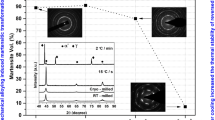Conclusions
-
1.
The formation of continuous Debye lines on x-ray diffraction patterns from reversed austenite of 50N25 and N31 alloys single crystalline in the original condition which have undergone repeated γ⇆α-transformations and their absence on microelectron diffraction patterns is caused by the different localization of the two diffraction methods. The recorded differences in the diffraction patterns are related to the different quantities of fragments of the structure in the different volumes of the material.
-
2.
Repeated thermal cycling treatment of alloys with γ⇆α-transformations led to gradual replacement of the dislocation mechanism of relaxation of internal stresses by the deformation twinning mechanism, which was caused by the increasing level of internal stresses and the interrelationship between the rules of formation of the structures of austenite and martensite.
-
3.
In the actual carbon-free iron-nickel alloy N31 the process of twinning of the reversed austenite developed more intensely than in 50N25 alloy as the result of the more complete transformation.
Similar content being viewed by others
Literature cited
V. G. Gorbach, "The phenomenon of phase strain hardening in γ→α→γ-transformations," in: Metal Physics [in Russian], No. 27, Naukova Dumka, Kiev (1970), pp. 5–39.
K. A. Malyshev, V. V. Sagaradze, I. P. Sorokin, et al., Phase Strain Hardening of Iron-Nickel-Based Austenitic Alloys [in Russian], Nauka, Moscow (1982).
V. E. Danil'chenko and V. I. Bondar', "The influence of phase strain hardening on the structure and strengthening of iron-nickel single crystals," Dokl. Akad. Nauk SSSR,275, No. 6, 737–744 (1984).
P. Yu. Volosevich, V. N. Gridnev, and Yu. N. Petrov, "The reverse transformation of martensite into austenite in iron-nickel alloys in rapid electrical heating," in: Metal Physics [in Russian], No. 57, Naukova Dumka, Kiev (1975), pp. 28–35.
P. Yu. Volosevich and Yu. N. Petrov, "The influence of rapid cyclic electrothermal treatment on the structure of nickel steel," Metalloved. Term. Obrab. Met., No. 1, 20–23 (1975).
V. V. Sagaradze, I. G. Kabanova, N. D. Pecherkina, and A. N. Malyshev, "Crystalline geometric features of the ferrite-austenite transformation and phase strain hardening of the austenite of high-chromium steels," Fiz. Met. Metalloved.,60, No. 3, 530–541 (1985).
Additional information
Institute of Metal Physics, Academy of Sciences of the Ukrainian SSR. Translated from Metallovedenie i Termicheskaya Obrabotka Metallov, No. 11, pp. 5–7, November, 1990.
Rights and permissions
About this article
Cite this article
Volosevich, P.Y., Girzhon, V.V. & Danil'chenko, V.E. The influence of repeated γ⇆α-transformations on the structure of iron-nickel alloys. Met Sci Heat Treat 32, 811–814 (1990). https://doi.org/10.1007/BF00700057
Issue Date:
DOI: https://doi.org/10.1007/BF00700057



